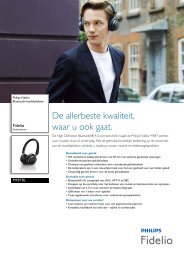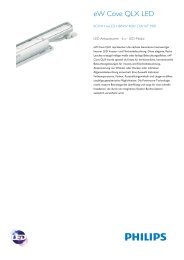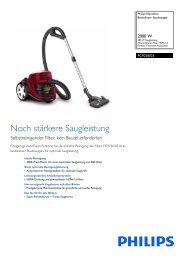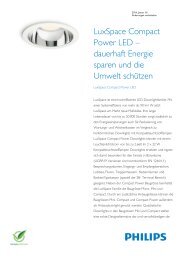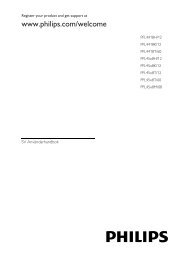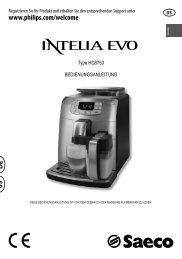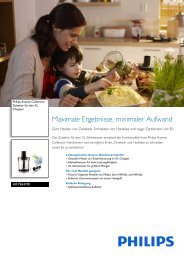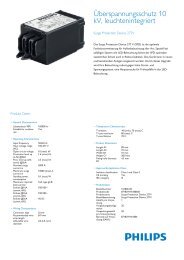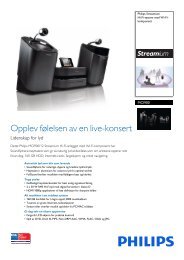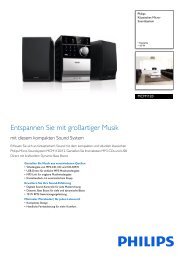HD6103 - Philips
HD6103 - Philips
HD6103 - Philips
Create successful ePaper yourself
Turn your PDF publications into a flip-book with our unique Google optimized e-Paper software.
English 7<br />
--<br />
Prevent water and/or ice from coming into contact with oil or fat, as this causes heavy spattering<br />
or violent bubbling of the oil of fat. To achieve this, remove all excess ice from frozen ingredients<br />
before you fry them and dry ingredients thoroughly before you fry them. Do not overfill the<br />
basket. After cleaning, dry all parts thoroughly before you put oil or fat in the fryer.<br />
--<br />
Do not fry Asian rice cakes (or similar types of food) in this appliance. This might cause heavy<br />
spattering or violent bubbling of the oil or fat.<br />
--<br />
Make sure the fryer is always filled with oil or fat to a level between the ‘MIN’ and ‘MAX’<br />
indications on the inside of the inner bowl to prevent either overflowing or overheating.<br />
--<br />
Do not switch on the appliance before you have filled it with oil or fat, as this can damage<br />
the appliance.<br />
--<br />
This appliance is not intended to be operated by means of an external timer or separate<br />
remote-control system.<br />
Electromagnetic fields (EMF)<br />
This <strong>Philips</strong> appliance complies with all standards regarding electromagnetic fields (EMF). If handled<br />
properly and according to the instructions in this user manual, the appliance is safe to use based on<br />
scientific evidence available today.<br />
Preparing for use<br />
1 Clean the appliance before first use (see chapter ‘Cleaning’).<br />
Make sure that all parts are dry before you fill the fryer with oil or fat.<br />
2 Open the lid (Fig. 2).<br />
3 Consult the oil/fat table to determine how much oil or fat you have to put in the fryer (Fig. 3).<br />
4 Fill the fryer with oil, liquid frying fat or melted solid fat to a level between the ‘MIN’ and<br />
‘MAX’ indications and close the lid (Fig. 4).<br />
Do not switch on the appliance before you have filled it with oil or fat.<br />
Oil and fat<br />
Never mix different types of oil or fat and never add fresh oil or fat to used oil or fat.<br />
--<br />
We advise you to use frying oil or liquid frying fat. Preferably use vegetable oil or fat that is rich<br />
in unsaturated fats (e.g. linoleic acid), such as soy oil, peanut oil, maize oil or sunflower oil.<br />
--<br />
Because oil and fat lose their favourable properties rather quickly, you have to change the oil or<br />
fat regularly (after 10-12 times).<br />
--<br />
Always change the oil or fat if it starts foaming when it is heated, if it has a strong smell or taste<br />
or if it turns dark and/or syrupy.<br />
Solid fat<br />
You can also use solid frying fat, but in that case extra precautions are necessary to prevent the fat<br />
from spattering and the heating element from overheating or becoming damaged.<br />
1 If you want to use new blocks of fat, melt them slowly over a low heat in a normal pan.<br />
2 Pour the melted fat carefully into the fryer.<br />
3 Store the fryer with the resolidified fat still in it at room temperature.<br />
4 If the fat gets very cold, it may start spattering when melted. Punch some holes into the<br />
resolidified fat with a fork to prevent this (Fig. 5).<br />
Be careful not to damage the inner bowl with the fork.



